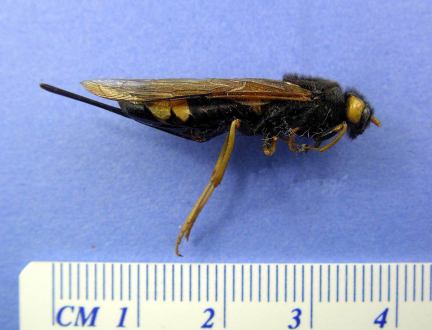Common Name: Banded Horntail, Greater Horntail, Yellow-horned
Horntail
Latin Name:
Urocerus gigas, Linnaeus 1758
(R. Bercha, det.)
Length: 10 to 40mm
(females larger then males)
Range: Throughout Alberta,
specifically the foothills and boreal forest
Habitat: Forested areas
Time of year seen: July
- September
(Additional Sightings)
Larva: Bores in dead, dying and damaged trees
Other: The Banded Horntail
is a large insect with a black cylindrical body marked with yellow bands on
the posterior and basal segments of the abdomen and amber colored wings.
The adults are strong fliers, which will travel long distances in search of
potential host trees. It is commonly found in the boreal forest and
the foothills regions of Alberta. They prefer to lay eggs in weak, damaged
or recently killed spruce trees and thus it is not unusual to find them
around recently burnt or logged areas. The female horntail uses her stout
ovipositor to bore into the tree or log and lay individual eggs. The
larva then hatch and bore tunnels 15 to 75cm in length into the first 4 cm
of wood. It takes 2 to 3 years before they emerge as adults.
These insects cause minimal damage to lumber. Although these insects
appear formidable with their long ovipositors and large bodies they do not
sting. |
